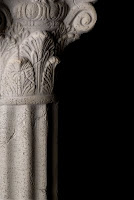 How many columns should a poster have?
How many columns should a poster have?Some designers find even numbers of divisions too symmetrical and staid, like folded paper. Thus, you may want to try for an odd number of columns, like three of five. Alternately, you might work with a grid that is some multiple of three.
There’s another reason to consider trisecting your poster space. Photographers and graphic artists often talk about the “rule of thirds.” The idea is that the most visually interesting images, pages or photographs often have their focal points off center, at one of the four points formed by intersections of imaginary lines that divide the space into thirds both vertically and horizontally.
This is easier to show than describe.

The red crosses show the preferred points for locating the items of most interest. In photography, these might be the eyes of the face, say. Locating things on those points in a technical poster is a bit more complex, but that’s a post for another time.
If there is any text that is long enough to form a paragraph, the size of the type has a major impact on column width, and therefore column number.
A narrow
skinny
column of
text can
be highly
annoying,
because you
are forced
to keep
sending your
eyes back to
the start of
the line.
Reading extremely wide paragraphs of text makes it easy to lose which line you’re reading as you continue to scan across. I’ve had to make the text very small to show an example of this phenomenon, because I can’t easily adjust the column width for this blog, so I hope you can see the point. Sorry for the eyestrain.
According to Jury (2002), a good guideline for paragraph width, and therefore column width, is about ten to twelve words per line of text. You will find plenty of situations where this guideline is not followed; some magazines have narrower columns, maybe six to eight words wide. Nevertheless, those principles alone probably give you a very solid starting point for a grid.
References
Jury D. 2002. About Face: Reviving the Rules for Typography. Rotavision SA: Mies.

















